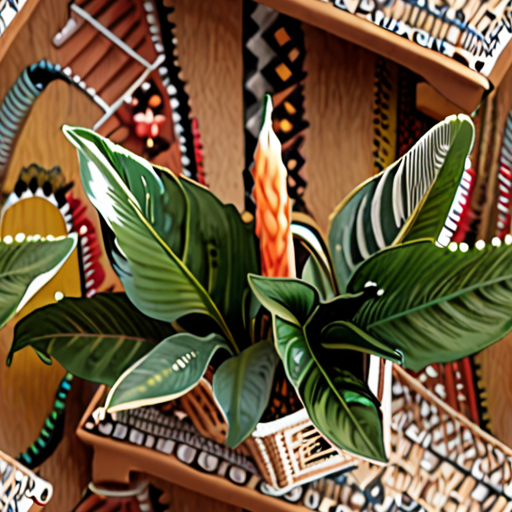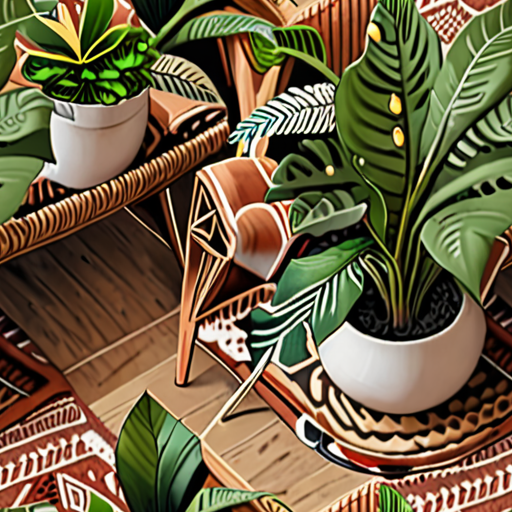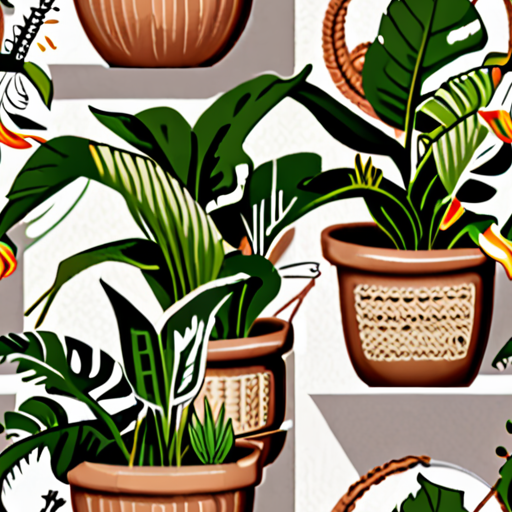As we continue to seek ways to bring life and serenity into our homes, one simple yet effective solution stands out – decorating with indoor plants. Not only do they purify the air and improve mental well-being, but they can also add a touch of natural beauty to even the most mundane spaces. From modern interior design ideas featuring lush greenery to traditional decorating styles that incorporate vibrant blooms, there’s a world of possibilities when it comes to decorating with indoor plants.

Decorating Indoor Plants
To create a visually appealing display with your indoor plants, consider combining plants of varying heights and using pedestals or plant stands to add depth.
- Experiment with a cascading effect by placing taller plants behind shorter ones, allowing the foliage to spill over the edges of pots or shelves.
- Boost smaller plants up onto pedestals or plant stands to create the illusion of larger plants, adding visual interest to your space.
- Group plants together in odd-numbered arrangements to create a balanced and harmonious display.
- Consider incorporating decorative planters or vases to add color and texture to your arrangement.
When selecting plants for your display, choose a mix of textures, shapes, and colors to create visual interest.
- Select plants with varying leaf shapes and sizes, such as succulents and ferns, to add depth and variety to your arrangement.
- Incorporate plants with different growth habits, such as trailing vines and upright shrubs, to create a dynamic display.
- Choose plants with vibrant flowers or colorful foliage to add pops of color to your arrangement.
Remember to leave enough space between plants to allow for proper air circulation and growth.
By following these tips, you can create a stunning and unique indoor plant display that adds beauty and life to your space.
What to Put Around Indoor Plants
We’ve all been there – struggling to keep our indoor plants healthy and thriving amidst the chaos of daily life. One often-overlooked aspect of indoor gardening is what we put around our plants. In this article, we’ll explore the various options available and provide you with expert advice on how to choose the best materials for your indoor garden.
- Mulch: Mulch is a popular choice among indoor gardeners due to its ability to retain moisture, suppress weeds, and regulate soil temperature. Organic mulches like wood chips, bark, or coconut coir work well, while inorganic options like gravel or stone can also be effective.
- Stones: Stones are another excellent option for indoor gardens, offering a decorative element while preventing weeds from growing. Choose from a variety of colors and textures to match your home decor.
- Pebbles: Pebbles are small, rounded rocks that can be used to cover the surface of your potting mix. They help with drainage and prevent waterlogged soil, making them ideal for plants that prefer well-draining conditions.
- Succulent Rocks: Succulent rocks are specifically designed for cacti and succulents, allowing excess water to drain through while retaining moisture in the soil. These rocks come in various shapes, sizes, and colors, adding a decorative touch to your indoor garden.
- Decorative Gravel: Decorative gravel is a versatile option that can be used to cover the surface of your potting mix or as a decorative element in your indoor garden. Choose from a range of colors and textures to suit your style.
- Straw: Straw is a biodegradable material that can be used to cover the surface of your potting mix. It helps retain moisture, suppress weeds, and regulates soil temperature, making it an excellent choice for indoor gardens.
- Newspaper: Newspaper is a cheap and eco-friendly option for covering the surface of your potting mix. It helps retain moisture, suppress weeds, and regulates soil temperature, making it suitable for indoor gardens.
- Coco Husk: Coco husk is a sustainable and eco-friendly alternative to traditional mulch. It retains moisture, suppresses weeds, and regulates soil temperature, making it an excellent choice for indoor gardens.
When choosing what to put around your indoor plants, consider factors like plant type, climate, and personal preference. By selecting the right material, you can create a thriving indoor garden that brings joy and serenity to your home.

Arranging Your Living Room with Plants
We believe that incorporating plants into your living room can greatly enhance its aesthetic appeal and air quality.
- When selecting plants for your living room, consider factors such as lighting, temperature, and humidity levels to choose species that thrive in these conditions.
- Grouping plants together can create a visually appealing display and help purify the air more efficiently.
- Choose a variety of plant sizes and shapes to add texture and visual interest to your space.
- Consider adding a statement piece, such as a large potted plant or a living wall, to draw attention to a particular area of the room.
Plant Placement Strategies
To maximize the impact of your plants, try placing them in strategic locations throughout the room:
- Place plants near windows to take advantage of natural light and promote healthy growth.
- Position plants away from heating vents and radiators to prevent overheating and drying out.
- Consider placing plants on shelves or ledges to add visual interest and create a sense of height.
- Don’t forget to leave enough space between plants for easy maintenance and airflow.
Care and Maintenance Tips
To keep your plants thriving, remember to:
- Water them regularly, but avoid overwatering, which can lead to root rot and other problems.
- Fertilize your plants seasonally to promote healthy growth and development.
- Prune or repot your plants as needed to maintain their shape and size.
- Monitor your plants for pests and diseases, and treat them promptly if necessary.

Biophilic Design: A Decor Style That Emphasizes Plants
This approach focuses on reconnecting humans with nature through interior design, promoting well-being and a sense of calm.
-
Key Features:
- Abundant use of plants and greenery
- Natural materials and textures
- Large windows and skylights for natural light
- Organic shapes and curves
-
Benefits:
- Improved air quality and reduced stress levels
- Increased productivity and focus
- Enhanced mood and overall well-being
- Connection to nature and the outdoors
-
Design Inspiration:
- Peck and Gartner’s collection of planters and indoor gardens
- The use of living walls and vertical gardens
- Bringing the outdoors in with natural textiles and patterns
- Creating a calming atmosphere with soft lighting and colors
-
Competitors:
- Houzz: A leading platform for home design and remodeling
- Home Depot: A retailer offering a wide range of home improvement products
- West Elm: A furniture and home decor brand emphasizing modern design
-
Best Practices:
- Use a mix of plants and greenery to create visual interest
- Choose low-maintenance plants for busy spaces
- Incorporate natural materials and textures for added depth
- Consider the color palette and lighting scheme when selecting plants
-
Resources:
- Houzz : A leading platform for home design and remodeling
- Home Depot : A retailer offering a wide range of home improvement products
- West Elm : A furniture and home decor brand emphasizing modern design
Decorating Your Bedroom with Live Plants
Transform your bedroom into a serene oasis by incorporating live plants into your decor.
-
Choose Low-Maintenance Plants
Select plants that thrive in indoor conditions and require minimal care, such as snake plants, spider plants, or ZZ plants.
-
Optimize Plant Placement
Place plants near windows to maximize natural light exposure and consider using mirrors to reflect light onto plants in low-light areas.
-
Utilize Vertical Space
Make the most of your walls by using wall-mounted planters, shelves, or trellises to display plants and keep floors clear.
-
Add Texture and Color
Incorporate plants with varying textures and colors to add visual interest and depth to your bedroom.
-
Create a Focal Point
Designate a statement piece, such as a large potted plant or a stunning floral arrangement, to draw attention and create a sense of drama.
-
Maintain a Consistent Aesthetic
Choose plants and planters that complement your bedroom’s style and color scheme to create a cohesive and harmonious atmosphere.
-
Prioritize Air Quality
Select plants known to purify the air, such as peace lilies or Boston ferns, to promote a healthier sleep environment.
-
Experiment with Different Shapes and Sizes
Vary the shapes and sizes of your plants and planters to add visual interest and prevent a monotonous appearance.
-
Consider the Five Elements
Balance the five elements – wood, fire, earth, metal, and water – in your bedroom by selecting plants that correspond to each element.
-
Keep it Fresh and Evolving
Rotate your plants seasonally to keep your bedroom feeling fresh and dynamic, and don’t be afraid to experiment with new arrangements and styles.

Interior Design with Plants
We often hear about the importance of incorporating plants into our homes, but have you ever wondered what this style of interior design is actually called?
- Indoor House Plant Design: Also known as interiorscaping, this style combines the art of interior design with the beauty of plants.
- Plant Savvy: At the intersection of eye for design and green thumb, you’ll find indoor house plant design or interiorscaping as we like to call it.
- Peck and Gartner: As a home improvement and interior design blog, we offer readers a wide range of DIY project ideas, home renovation tips, and design inspiration.
- DIY Project Ideas: From building a custom bookshelf to creating a statement piece of furniture, our DIY projects are perfect for those who want to get creative and save money.
- Home Renovation Tips: Whether you’re planning a major overhaul or just need some advice on how to tackle a small project, our home renovation tips are here to help.
- Design Inspiration: Our design inspiration section is packed with ideas and inspiration to help you create a beautiful and functional living space.
- Expert Insights: We’ve partnered with experts in the field to bring you the latest design trends and advice on how to incorporate plants into your home decor.
- Competitors: Other popular interior design blogs include Houzz and Apartment Therapy, which offer a wealth of information and inspiration for those looking to improve their living spaces.
When it comes to choosing the right plants for your interior design, there are several factors to consider, including lighting, temperature, and humidity levels.
- Lighting: Most houseplants prefer bright, indirect light, but some can tolerate low light conditions.
- Temperature: Make sure to choose plants that thrive in temperatures between 65-75°F (18-24°C).
- Humidity: Some plants prefer high humidity levels, while others can tolerate dry air.
By considering these factors and choosing the right plants for your space, you can create a beautiful and thriving indoor garden that brings joy and serenity to your home.
Conclusion
Incorporating plants into your interior design can be a great way to add visual interest and create a sense of calm in your home. By understanding the basics of indoor house plant design and choosing the right plants for your space, you can create a stunning and sustainable indoor garden that brings joy and serenity to your life.

0 Comments